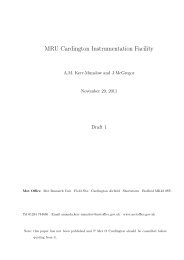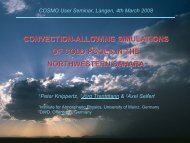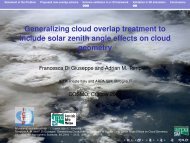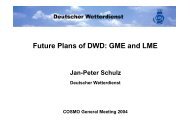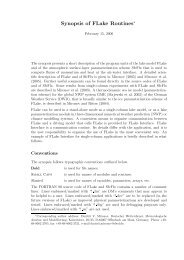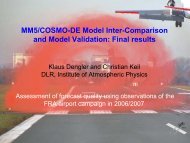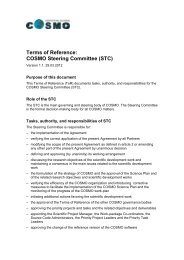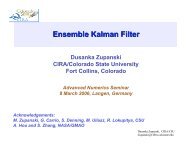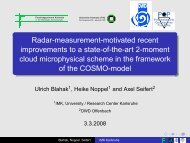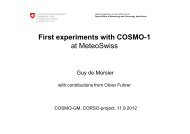document - Cosmo
document - Cosmo
document - Cosmo
You also want an ePaper? Increase the reach of your titles
YUMPU automatically turns print PDFs into web optimized ePapers that Google loves.
1 Working Group on Data Assimilation 27<br />
resulting amplification factors which are summarised in Fig. 2a). It becomes evident that<br />
even medium-intensity ground clutter signals can be dramatically amplified in unstable environments<br />
and, therefore, hamper the precipitation assimilation substantially. This occurs<br />
when the forcing induced by the spurious echo is sufficient to lift air parcels to their level<br />
of free convection. For instance, a clutter signal of 20 mm/h nudged during 10 min into an<br />
environment with a CAPE of 1200 J/kg, is amplified by a factor of 15, while in a 400 J/kg<br />
environment a 50 mm/h clutter amplifies by a factor of 3 after 8 minutes, i.e. even for relatively<br />
moderate instabilities amplification of the signal (ratio larger than 1) takes place after<br />
modest total forcing. Accompanying updrafts easily reach values between 10 and 20 m/s.<br />
This scatter plot suggests the existence of a threshold forcing, for the present configuration<br />
at R f between 2.5 and 3 mm, above which air parcels do reach their level of free convection,<br />
and the instability is released. However, there are cases with a larger total forcing, e.g. 10<br />
mm resulting from a combination of small clutter intensity and long forcing time, in which<br />
the level of free convection is not attained. This may partly be due to an interference of the<br />
LHN forcing with the model dynamics (such as numerical diffusion), when the convective<br />
system starts to develop in the model. Investigation of this is beyond the scope of the present<br />
study.<br />
A slightly different way of representation is given in Fig. 2b), in which the critical forcing<br />
time t crit, i.e. the minimum time for a given amplitude to reach amplification, is depicted<br />
for several degrees of instability. Again, for unstable environments even very small amplitude<br />
signals are amplified given sufficient forcing time. For high-amplitude signals dramatic error<br />
amplification is almost immediate, i.e. takes place after as little as a few minutes. For smaller<br />
values of CAPE and clutter amplitude, however, the assimilation scheme is able to dampen<br />
the error.<br />
In the light of these results and given that real ground clutter amplitudes often reach, or even<br />
exceed, such amplitudes, a thorough clutter elimination in convectively unstable situations<br />
seems to be fundamental.<br />
3.3 Real case example<br />
In order to illustrate what can happen in real cases of clutter, Swiss Radar Network (SRN)<br />
data for a non-rain day are assimilated for a six hour period into the experimental setup of<br />
this study using the reference profile with CAPE=800 J/kg (Fig. 1a). The simulation was<br />
performed with the setting used by LR05, i.e. a model domain of 361 × 333 horizontal grid<br />
points, with a mesh size of 2.2 km and 45 vertical levels. The six hour accumulation of the<br />
resulting model precipitation (Fig. 3b) exhibits dramatic amplification of the original clutter<br />
signals. It is evident that regions of large coherent clutter amplify to larger intensities than<br />
pixel-sized signals, as the former are less dampened by the model’s numerical diffusion scheme<br />
that acts primarily on the structures with sizes of the order of the gridlength. The problem is<br />
somewhat mitigated if the SRN data are run through a Shapiro type observation filter with<br />
length 4 (Shapiro 1975) (Fig. 3c). In addition, the presence of appreciable wind causes the<br />
precipitation resulting from the clutter assimilation to be exported to neighbouring regions,<br />
in which new convection can be triggered (Fig. 3d).<br />
3.4 Anomalous propagation conditions<br />
The signal resulting from anomalous propagation of the radar beam is another important<br />
source of non-rain echoes (e.g. Koistinen et al., 2004). In contrast to regular ground clutter,<br />
anomalous propagation clutter can be more coherent in space but more intermittent in time.<br />
COSMO Newsletter No. 6




